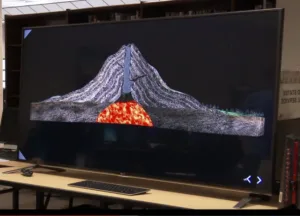In an article published earlier this month (A 3D Success Story: The Wilson County Schools), I highlighted the efforts of the Wilson County Schools, a mid-sized district in Tennessee that was honored with one of ISTE’s highest awards, the ISTE Digital Content and Curriculum Achievement Award for 2016, for “Immersing students with 3D and Virtual Reality Content.”

But there is an interesting story-behind-the-story in all this—some lessons to be learned that can inform just about any display manufacturer, integrator, or sales group contemplating outreach to the education market. Here is my drill-down interview with Nina Williams, one of the project leaders for this award-winning effort, followed by my own observations and gleanings that will certainly be of interest to the display industry:
Lessons learned about the use of 3D and virtual reality in classroom instruction.
Nina Williams suggested that the approach they used “brought new realization” to the mind’s eye of the children—in essence—a deeper form of learning. After students viewed a clarifying Sensavis 3D simulation and finally came to understand a concept, the students would exclaim “’That’s what it’s like!” according to Williams. Williams provided this thoughtful example of the kinds of “deeper learning” that was evidenced by students: “Drawing an inference is very difficult for children. With 3D, children are able to infer like never before. In one lesson, we were teaching the process of hearing by watching the animation of a sound wave. Students witnessed the sound wave shaking the ear drums; and the closer the sound source moved toward the ear, they could see the increasing damage to the ear drum. These students realized for the first time exactly why their parents were telling them to ‘take the ear buds out and put headphones on!’ Clearly, the louder it got, the more damage could be occurring, the students realized…”
Lessons learned about putting students to work
Perhaps the most interesting aspects of this award-winning initiative involved putting students to work—not just viewing 3D content, but energizing the students to produce mini-content reels themselves—and then converting that content to VR-readable format. I asked Nina Williams how well the students succeeded in shaping Sensavis stereo 3D content and then having students reproduce it in VR format. Her answer? “Students used content knowledge they gained from their unit study and merged that with the 3D content. They then created their 3D videos in which they explained in detail concepts and content to prove they had learned the necessary subject matter”, she explained. “[We met] with overwhelming success”, she then beamed.
Lessons learned about evaluating the success of an initiative
Smartly, the Wilson County School leaders were effectively tracking results. “Most of the assessments were summative assessments; students explained in detail key concepts and content and had to prove they had learned the necessary subject matter.” She added: “We now have several 3D videos [viewed through VR headsets] that students turned in for summative assessments. We also have testimonials and video clips from students and teachers who have used the content in which they discuss the impact of learning core content with the assistance of the 3D Sensavis software.”
Lessons learned about scaling a project
As a strategy for scaling their project, Wilson County Schools’ leaders first aimed their sights at teachers that were interested in moving forward with visualization. “It cannot be a forced”, suggested Williams. “We wanted to target those teachers that really wanted to use it. And for the rest, we installed the software in at least one open-access computer lab so they could jump in when ready.” More importantly, these thoughtful leaders creatively relied on the students themselves to move the learning initiative forward. “Students, not teachers, were assigned various topics and began working together to create actual lessons, creating their own narrations, explanations, and even questions.”
Some worthy conclusions
In order to successfully sell displays, 3D, virtual reality, or nearly any technology to the education market—and garner considerable attention and awards along the way—manufacturers need a clearer understanding of how to succeed in this market. Some of the takeaways from the Wilson County Schools project can be helpful in this regard:
- Be prepared to show how your technology actually contributes to learning.
- Look for “deeper learning”, not just the low-lying fruit of engagement or recall
- Discover how to involve students with your technology, not just the teachers; put the learners to work
- Invest in school projects that will assess and evaluate your technology, not just ‘use’ it
- Find customers that know how to scale technology implementations effectively; and if they don’t know how, give them a helping hand—even if they don’t want the help
This is the real story-behind-the story. Mull over these suggestions. –Len Scrogan

